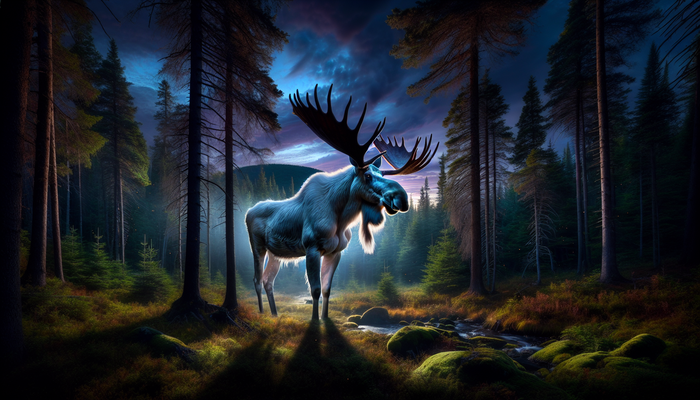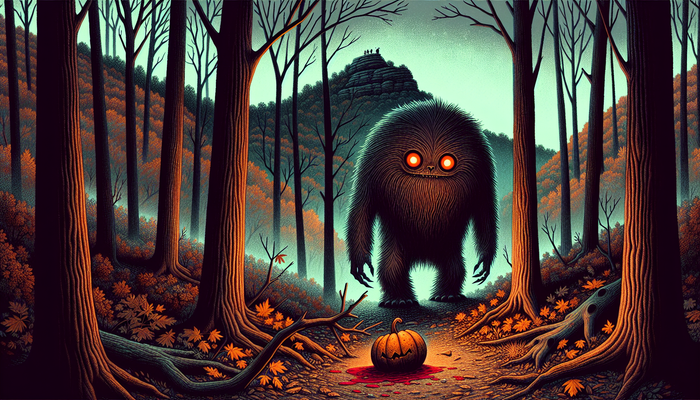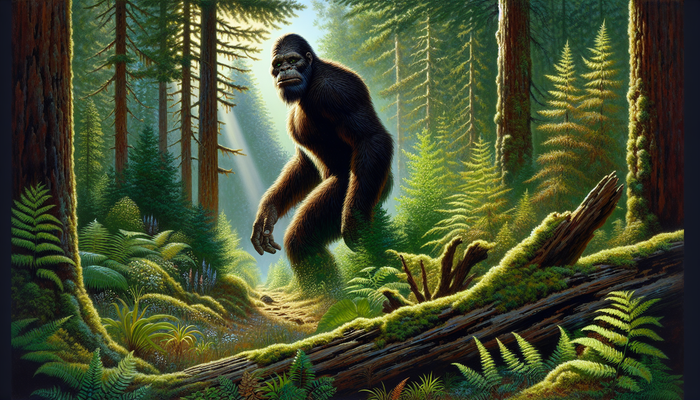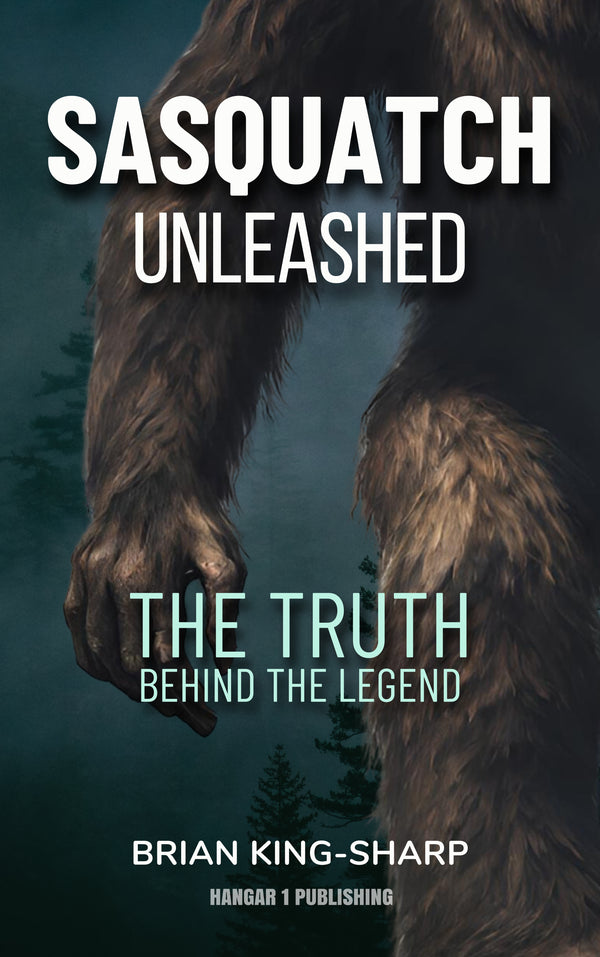Maryland's Bigfoot Sightings

By Ava Martinez, Cryptozoologist
In the realm of cryptozoology, few creatures have captured the human imagination as profoundly as Bigfoot. This elusive, bipedal humanoid, known by many names across cultures and continents, has been the subject of countless stories, investigations, and debates. While the Pacific Northwest may be the most famous hotspot for Bigfoot sightings, a surprising contender has emerged in the eastern United States: the state of Maryland. With over 300 documented encounters, Maryland ranks fifth nationally in reported Bigfoot sightings, a statistic that has piqued the interest of researchers and enthusiasts alike. As a biology teacher and passionate cryptozoologist, I have long been fascinated by the rich history and diversity of Bigfoot encounters in the Free State. In this article, I will delve into the mystery of Maryland's Bigfoot sightings, exploring the deep roots of the legend, examining pivotal cases, and considering the implications of this enduring enigma for our understanding of the natural world.
The Deep Roots of Bigfoot Lore in Maryland
The concept of a large, hairy, humanoid creature roaming the wilderness is not a recent invention in Maryland. In fact, the roots of Bigfoot lore in the state can be traced back centuries to the legends of the indigenous Piscataway people. The Piscataway spoke of the "Okee," a shape-shifting, monstrous spirit that was both revered and feared. Described as a hairy, powerful entity, the Okee bears a striking resemblance to modern descriptions of Bigfoot. These ancient legends suggest that the idea of a Bigfoot-like creature has long been a part of Maryland's cultural landscape.
In addition to Native American folklore, early historical accounts from European settlers also hint at the presence of "wildmen" and "hairy giants" in the region. In the early 1900s, M.P. Edwards, a resident of Chestertown, recounted a childhood experience in which he and his brother discovered huge, human-like footprints while investigating the mysterious slaughter of their calves. Similarly, in 1909, farmer Albert Evans of Dorchester County claimed to have seen a "dark-haired, 7-foot tall man-beast" standing over several dead cows. These early reports, predating the modern Bigfoot craze, suggest a long-standing tradition of encounters with large, bipedal creatures in Maryland's rural areas.
The enduring legacy of these early legends and accounts cannot be overstated. They have shaped the cultural context in which modern Bigfoot sightings are interpreted and have contributed to the rich tapestry of Maryland's cryptozoological heritage. As we explore more recent encounters, it is essential to keep in mind the deep historical roots of the Bigfoot phenomenon in the state.
The Sykesville Monster: A Turning Point in Maryland Bigfoot History
In 1973, the small town of Sykesville in Carroll County became the epicenter of a series of Bigfoot sightings that would forever change the landscape of cryptozoology in Maryland. The events began with multiple independent eyewitness accounts of a large, hairy, bipedal creature spotted along the railroad tracks and in the surrounding woods. The consistency of these reports, coming from credible sources, prompted a serious investigation by local authorities.
The Sykesville Monster, as the creature came to be known, was described as a tall, humanoid figure covered in dark hair, with a powerful build and a distinctive gait. Witnesses reported seeing the creature crossing roads, lurking in the shadows of the forest, and even leaving behind large, human-like footprints. The most significant piece of evidence to emerge from the Sykesville sightings was a plaster cast of a 13-inch footprint, which was analyzed by police and zoo officials. The size and shape of the print, with its clear toe impressions and anatomical details, suggested that it could not have been made by any known animal native to the region.
The Sykesville Monster sightings marked a turning point in Maryland's Bigfoot history. They garnered widespread media attention, bringing the topic of Bigfoot into the public consciousness and sparking a renewed interest in the mystery. The involvement of law enforcement and scientific experts lent credibility to the investigation, setting the stage for a more serious approach to the study of Bigfoot in the state. The legacy of the Sykesville Monster endures to this day, serving as a benchmark for subsequent sightings and investigations in Maryland.
The Goatman Connection: A Bizarre Twist in the Maryland Bigfoot Saga
As the Sykesville Monster sightings were unfolding, a bizarre parallel phenomenon emerged in nearby Prince George's County. Reports began to surface of a creature known as the "Goatman," described as a half-human, half-goat monstrosity that terrorized local residents. Eyewitnesses claimed to have encountered the Goatman in parks, along roadsides, and even in their own backyards. The creature was said to have glowing red eyes, a foul odor, and a penchant for attacking cars and livestock.
The concurrent emergence of the Goatman legend alongside the Sykesville Monster sightings has led some researchers to speculate about a possible connection between the two phenomena. One theory suggests that the Goatman reports may have been the result of misidentification or confusion, with witnesses mistaking Bigfoot sightings for something more bizarre and supernatural. Alternatively, some have proposed that the Goatman legend was a deliberate hoax or distraction, intended to draw attention away from the more credible Bigfoot encounters in the area.
Regardless of the true nature of the Goatman, its presence in Maryland's cryptozoological lore adds a layer of intrigue and complexity to the Bigfoot mystery. The Goatman legend, with its overtones of the occult and the supernatural, stands in stark contrast to the more grounded, biological theories surrounding Bigfoot. Yet, the two phenomena are forever linked in the minds of many Marylanders, a testament to the enduring power of local folklore and the human fascination with the unknown.
Modern Maryland Bigfoot Encounters: The Search Continues
While the Sykesville Monster and Goatman incidents of the 1970s may be the most famous chapters in Maryland's Bigfoot history, the search for the elusive creature has continued unabated in the decades since. Modern sightings and encounters, bolstered by advances in technology and investigative techniques, have added new layers to the mystery and fueled ongoing research efforts.
One of the most compelling modern cases is the Arundel Mills incident of 2000. In the early hours of July 31, construction workers at the Arundel Mills Mall site in Hanover reported seeing a 12-foot-tall, fur-covered bipedal creature lurking in the shadows. The workers, visibly shaken, called 911 to report the sighting, prompting a police response. Officers on the scene later discovered a large, human-like footprint measuring 15 to 20 inches in length. Despite attempts by authorities to downplay the incident as a bear sighting, the eyewitness accounts and physical evidence have kept the case alive in the minds of Bigfoot researchers.
Another notable modern encounter occurred in 1981 along the Patapsco River, where Lon Strickler, a Maryland resident, claimed to have had a harrowing face-to-face encounter with a Bigfoot-like creature. Strickler described the creature as a 7-to-8-foot-tall, hair-covered humanoid that emerged from the brush and engaged in a brief altercation with a stray dog. The creature, according to Strickler, emitted a strong, musky scent that lingered in the air even after it had retreated into the woods. Strickler's attempt to report the incident to the police was met with a suspicious and abrupt response, leading him to believe that a cover-up may have been at play.
These modern sightings, along with countless others reported across the state, serve as a reminder that the Bigfoot mystery in Maryland is far from solved. From the Patapsco Valley State Park to the Blackwater Wildlife Refuge on the Eastern Shore, encounters with large, bipedal humanoids continue to be reported by credible witnesses. As technology improves and research efforts intensify, the hope remains that definitive evidence of Bigfoot's existence in Maryland will one day be uncovered.
Theories and Speculations: The Nature and Origins of Maryland's Bigfoot
As the body of evidence for Bigfoot's presence in Maryland grows, so too do the theories and speculations about the nature and origins of this enigmatic creature. Researchers and enthusiasts have proposed a range of hypotheses, each seeking to explain the persistent sightings and encounters in the state.
One popular theory suggests that Bigfoot may be a surviving population of Gigantopithecus, a genus of extinct giant apes that once roamed the forests of Asia. Proponents of this idea point to the similarities in size and morphology between Bigfoot descriptions and the estimated characteristics of Gigantopithecus. They argue that a small population of these ancient apes may have crossed the Bering Land Bridge during the Pleistocene epoch, eventually adapting to the North American environment and giving rise to the modern Bigfoot. While intriguing, this theory is challenged by the lack of fossil evidence for Gigantopithecus in the Americas and the significant time gap between its extinction and the emergence of Bigfoot sightings.
Another hypothesis proposes that Bigfoot could be an undiscovered species of North American ape, a primate that has somehow managed to evade scientific detection and classification. This theory draws on the fact that new species of primates, such as the Bili ape of the Congo Basin, have been discovered in recent decades, often in remote and inaccessible regions. Advocates of this idea suggest that the vast, dense forests of Maryland and the surrounding states could provide ample habitat for a reclusive ape species to thrive undetected. However, skeptics argue that the likelihood of a large, breeding population of primates going unnoticed in a heavily populated region like the eastern United States is extremely low.
A more controversial theory posits that Bigfoot may be a relict population of an archaic human species, such as Homo erectus or Neanderthal, that has somehow survived into the present day. This hypothesis is based on the humanoid characteristics often ascribed to Bigfoot, such as bipedalism, tool use, and even language. Proponents argue that the remote, mountainous regions of Maryland could have provided a refuge for these ancient hominins, allowing them to persist long after their extinction elsewhere. However, this theory is met with skepticism from the scientific community, as it would require a significant revision of our understanding of human evolution and the fossil record.
Other, more fringe theories have also been proposed, ranging from the idea of Bigfoot as an interdimensional or paranormal entity to speculation about extraterrestrial visitation or genetic experimentation. While these ideas may capture the imagination, they lack the scientific grounding and empirical evidence necessary to be taken seriously by most researchers.
Ultimately, the nature and origins of Maryland's Bigfoot remain a mystery, one that continues to inspire research, debate, and speculation. As new evidence emerges and scientific techniques advance, it is possible that one or more of these theories will be validated or refuted. Until then, the quest to understand the true identity of this elusive creature will continue to drive the efforts of dedicated researchers and enthusiasts across the state.
The Government Connection: Conspiracy Theories and Cover-Ups
One of the most intriguing and controversial aspects of the Maryland Bigfoot phenomenon is the alleged involvement of government agencies and the military in suppressing evidence and covering up sightings. Numerous eyewitness accounts and researcher reports have pointed to suspicious official responses to Bigfoot encounters in the state, fueling speculation about a possible government conspiracy to keep the truth hidden from the public.
In several high-profile cases, such as the Sykesville Monster and Arundel Mills incidents, witnesses have described swift and coordinated efforts by law enforcement and other agencies to downplay or discredit their experiences. These responses, often involving the sudden appearance of unmarked vehicles, the confiscation of evidence, and the intimidation of witnesses, have raised questions about the motives and knowledge of the authorities involved.
Lon Strickler's experience following his 1981 Patapsco River encounter is a prime example of the alleged government interference in Bigfoot investigations. After reporting his sighting to the police, Strickler claims he was quickly and aggressively ordered to leave the scene, with no explanation provided. In the days that followed, he found himself stonewalled by officials and media outlets alike, leading him to suspect a coordinated effort to silence him and suppress any further inquiry into the incident.
Similar stories of intimidation and cover-ups have been reported by other researchers and witnesses across Maryland, suggesting a pattern of official secrecy surrounding the Bigfoot phenomenon. Some theorize that the government may be aware of the creature's existence and is actively engaged in a campaign to keep this knowledge from the public. Speculations range from the idea of a secret research program studying captured Bigfoot specimens to the notion that the creatures are being protected as part of a clandestine conservation effort.
Proponents of these conspiracy theories point to the government's history of secrecy surrounding other controversial topics, such as UFOs and classified military projects, as evidence that a Bigfoot cover-up is plausible. They argue that the discovery of a large, unknown primate species in North America would have profound scientific, ecological, and social implications, potentially disrupting established paradigms and challenging human dominance over the natural world.
However, skeptics counter that the evidence for a government conspiracy is largely circumstantial and anecdotal, relying heavily on the testimony of individuals who may have misinterpreted or exaggerated their experiences. They point out that the sheer scale and complexity of a hypothetical Bigfoot cover-up would make it nearly impossible to maintain, especially in an age of widespread digital communication and social media.
Ultimately, the truth behind the alleged government connection to the Maryland Bigfoot mystery remains elusive. While the accounts of witness intimidation and official secrecy are compelling, they must be weighed against the lack of concrete evidence and the inherent challenges of proving a conspiracy theory. As with many aspects of the Bigfoot phenomenon, the question of government involvement is likely to remain a subject of intense debate and speculation among researchers and enthusiasts for years to come.
The Cultural and Folkloric Significance of Maryland's Bigfoot
Beyond the scientific and investigative aspects of the Maryland Bigfoot phenomenon, it is important to recognize the creature's profound cultural and folkloric significance within the state. Bigfoot has become a deeply ingrained part of Maryland's regional identity, inspiring a rich tradition of art, literature, and popular culture that reflects the enduring fascination with this enigmatic being.
In many parts of the state, Bigfoot has become a focal point for tourism and community events. Festivals, conferences, and exhibitions dedicated to the creature draw thousands of visitors each year, providing a boost to local economies and fostering a sense of shared interest and camaraderie among attendees. These gatherings often feature presentations by renowned researchers, displays of alleged Bigfoot artifacts, and even guided expeditions into the surrounding wilderness, allowing participants to immerse themselves in the lore and mystery of the phenomenon.
Bigfoot's influence can also be seen in the vibrant artistic and literary traditions of Maryland. Local artists have long been inspired by the creature, creating paintings, sculptures, and other works that depict Bigfoot in a variety of styles and contexts. These range from realistic portrayals of the creature in its natural habitat to more abstract and symbolic representations that explore the deeper psychological and spiritual dimensions of the legend.
From Bigfoot to UFOs: Hangar 1 Publishing Has You Covered!
Explore Untold Stories: Venture into the world of UFOs, cryptids, Bigfoot, and beyond. Every story is a journey into the extraordinary.
Immersive Book Technology: Experience real videos, sights, and sounds within our books. Its not just reading; its an adventure.



























